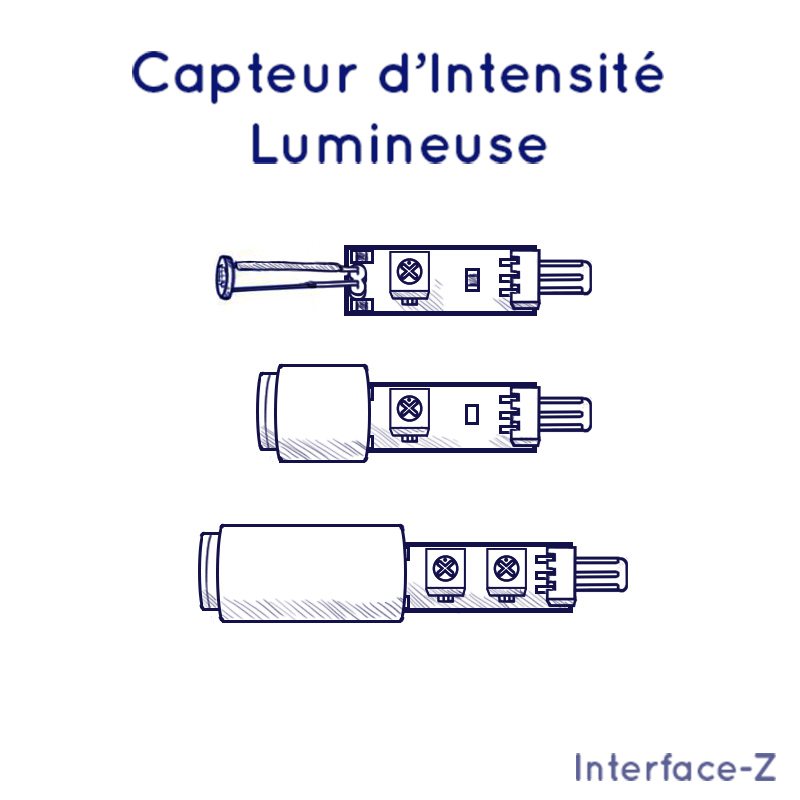



















These sensors can be used as presence detectors, movement or passage detectors, ambience sensor. It can even measure distance to a certain extent, like in the case of an optic range-finder used as a musical instrument (for more information visit « Mesures de distance », « Measuring distance »).
Principle : the LDR is a photoresistor, a photoelectric cell that sensitive to the amount of light it receives. A light variation (or shade) will cause the signal to vary. It's a passive sensor (*).
We can offer various kinds :
- Simple LDR
- Daylight LDR
- Directional LDR
- Ultra-directional LDR
These sensors are sensitive to visible and infrared light. To make invisible optic systems, we also offer small infrared spotlights.
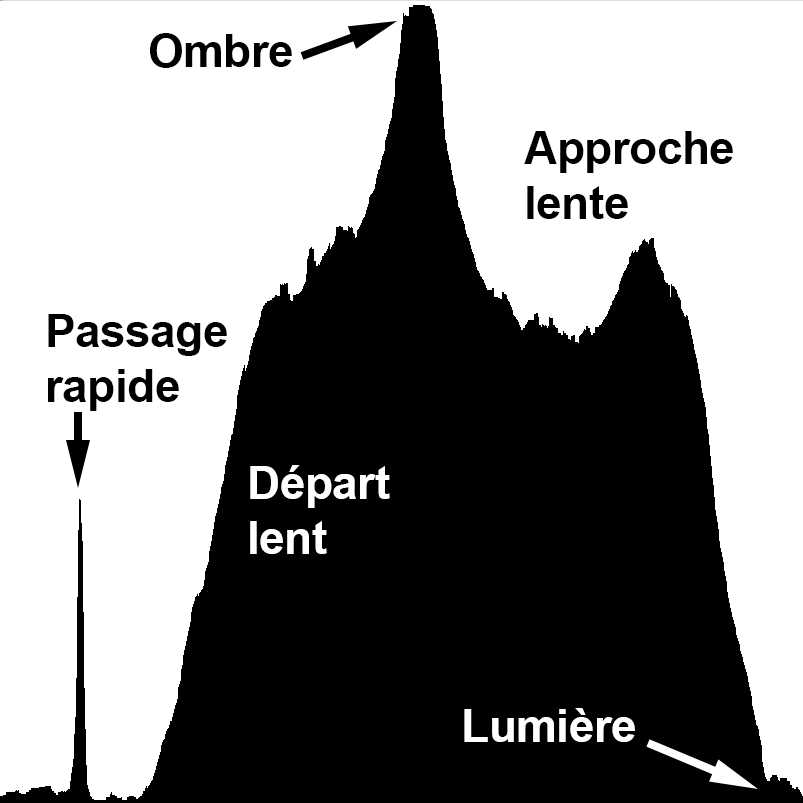
Data returned by the sensor over time
Datoo, Tu me fais tourner la tête :
- Art work presentation
Light intensity sensor – LDR by Interface-Z
The returned signal is proportional to the detected light's intensity. These sensors can be used to subtly detect movements, or the light variation of a movement's shadow
No added lens. This sensor is perfect for detecting dropped shadows in a specific place.
It reacts to shadows directly dropping upon the sensor. It is also sensitive to the ambient light of a room. It must be used with a specific light source, working as an optic barrier put up between the sensor and the light that other elements may cross and provoke variations, or to monitor the change in lighting within a place.
|
|
 |
A calibration potentiometer lets one adjust the sensor to the ambient brightness. When the lighting is bright, the sensor should return a low value. The value increases when a shadow is dropped on the sensitive part. This sensor version is not made to work outdoors (see the Daylight LDR below).
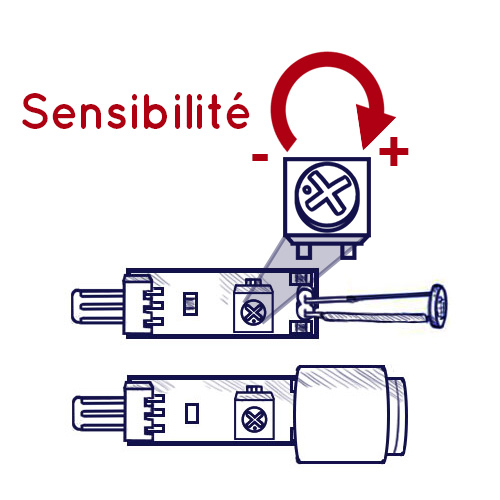
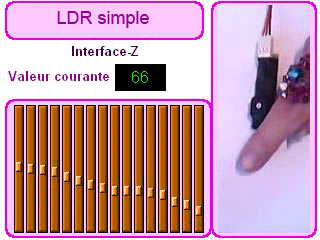
Visualization of the sensor's returned data : video LDR-simple-IZ.mov
(with sound). This display was made in Isadora. The most recent data is on the left, and the rest shows the variation over time perceived by the sensor. The shadow created by the finger provokes a value increase in the data sent by the sensor.
This display was made in Isadora. The most recent data is on the left, and the rest shows the variation over time perceived by the sensor. The shadow created by the finger provokes a value increase in the data sent by the sensor.
Careful ! Do not forget to order the 3 way extension cords, for they are sold separately.
This sensor behaves in the same way as the simple LDR, with the exception that this one can monitor the ambiant lighting outdoors. The simple LDR previously mentionned is made for indoors, and for artificial light. Sunlight is much brighter, even covered by clouds, than indoor lighting.
This LDR also has an electronic card with a calibration potentiometer to adapt to the brightness of ambient light. When it is bright, the sensor returns a low value, that increases when covered by a shadow or if it gets cloudy or if the sun goes down.
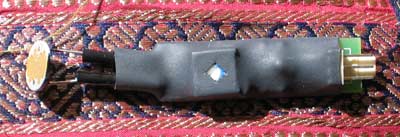
This sensor acts as a 1 pixel camera. It lets one perceive someone passing by, and any light variation. To work, a shadow doesn't need to be dropped directly upon the sensor, it monitors the light variations in a cone in front of it. For instance, it will detect someone passing by against a bright wall. It only requires a bit of contrast between the object or person and the background.
A calibration potentiometer lets one adjust the sensor to the ambient brightness.
When it is bright, the sensor returns a low value, that increases when a shadow is cast over it or when a contrasting object or person moves within the observation range of the sensor.

This sensor is much more directional (observation range angle is much smaller) than the previous one. It can detect a very specific passage or movement, if placed in front of a light shining upon it. It can be used as an optical barrier to do simple counting.
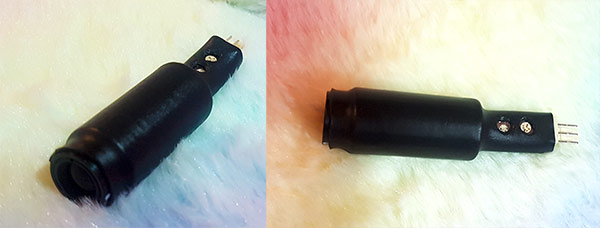
Unlike the other LDR, the ultra-directional LDR is practically unaffected by ambiant light variations, which is practical on a stage or in front of a screening, but it is usually paired with a specific direct and stable lightsource. The lightsource itself can be directional and discreet, and must be directed exactly towards the sensor. The greater the distance between the sensor and the lightsource (a few meters, must be tested), the more precisely it needs to be directed and the stronger the lightsource must be. A small directional LED lamp is suitable for example.
The sensor has two calibration potentiometes to adapt to the lighting conditions, and to the distance and reactiveness one wishes for. When it is bright, the sensor returns a low value. The value increases when someone or something comes between the sensor and the lightsource.
The potentiometer that is the nearest to the 3 pin connector is for adjusting sensitivity amplification (gain). The second one near the other side of the sensor is for adjusting the rest value (zero), in the event that one is not detecting passage.

The returned signal is all or nothing : 0 when it is bright, maximum value (127 in Midi protocol) when someone or something passes by or if a shadow is cast upon the sensor. The sensor still has a 3 pin output that plug (via an extension cord) onto an analog input of our interface cards, and not on their digital inputs which one might expect for an all or nothing signal (for example of the difference see on our 12 analog 16 digital input to midi interface card).
They are useful for detecting passage, closeby or further away depending on the lightsource. The threshold is set by the electronic card connected to the LDR that directly processes the data. It is adjustable in the same way as most analog sensors.
The ultra-directional sensor is not available in all or nothing because the system with 2 calibration potentiometers cannot be transposed. In its analog mode, it is already possible to set the sensor in almost all or nothing.
This module lets one easily and precisely detect a movement on a video , without using a computer.
This version is no longer available in our catalog, but we have left the information available.
More information can be found on the page "Comparaison tapis – camera" Comparing a sensitive mat and a camera.
You might also like